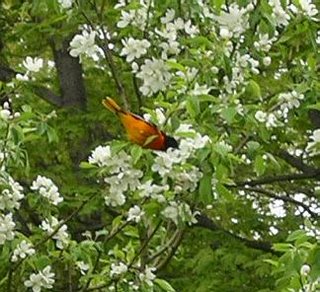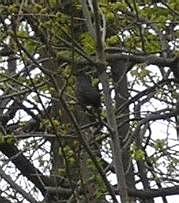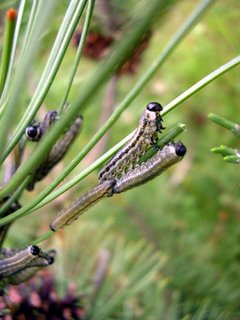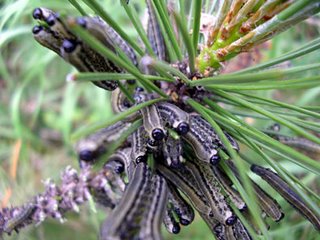I've been down in Prince Edward County since a week ago Monday, and have been wanting to write about the birds here since a day or two after I arrived, but I couldn't winnow out the story from the mass of experience. I still haven't really.
Prince Edward County is almost an island that reaches out into Lake Ontario--it's southernmost point, Prince Edward Point experiences huge fallouts of spring migrators--the Pelee of eastern Ontario. (Here's a link to the
Prince Edward Bird Checklist) This place is great for birds all year round--as I've written before. But I've never spent so much time here in May before (during the
birding festival), not since I've taken up "serious" birding anyway. Well, it's excessive! The place I'm staying is on the south shore, just a few kilometres from Prince Edward Point. And some mornings in the past several days, or when the weather was mixed, some afternoons, the trees around the house have been just full of warblers.
I cheered when
John at A DC Birding Blog finally got to see a cerulean warbler. I enjoyed the stories of Mike at
10,000 Birds getting together with Charlie of
Charlie's Bird Blog to go out and look for a cerulean of their own. Then, I, who has heard but never seen this same bird, was tortured by one singing high in the trees just off the edge of the yard here for several hours. I could hear it from inside the house (where I was trying to work), and was drawn out over and over to try again to catch a glimpse of it--I never did. A couple of days later another came to sing but by then, thankfully, I had finally relaxed. Let them sing--I'm pleased just to hear them.
The cerulean is a bird of interest to me not just for its relative rarity or its reputed beauty, but also because it's a bird I identified a couple of years ago entirely from hearing it sing and comparing that to recordings of other ceruleans singing. On the one hand this is an extremely distinctive singer to my ears--on the other, of the now three individuals I've heard, only the third sang a "textbook" cerulean song.
Listening to so many singers these past 10 days (and still being a very beginning song identifier), I am more convinced than ever that birds sing what they want to--they don't learn their songs from the recordings that birders use. At times there were large numbers of yellow-rumped warblers here, many singing--and singing not just at different volumes, but also at different speeds! Fortunately I was able to see a lot of the singers to confirm this. I also got a chance to relearn the American redstart song styles. I wrote on this blog last year that the redstart sings "who, who, who, julio (hoolio)," and then was uncomfortable about it afterwards. I'd hear/see a singing redstart that was saying nothing of the kind. Well, it turns out, sometimes they do sing this--then they sing something else for a while.
Today the yard was full of Baltimore orioles--a couple would be singing from the treetops--four more would chase each other around in a colourful aerial parade.

Also singing, sometimes from the same treetop, an orchard oriole (not to mention the singing catbird, who'd borrowed a few oriole notes). So I was able to confirm that what I did hear that terrible inattentive day last spring in the far field at home in my atlassing square was an orchard oriole singing. It does sound, to me, like a Baltimore oriole who's forgotten the tune.

Then, the thing that got me to sit down and write something, late this afternoon, in the rain, a couple of northern parulas (and another bird, who will remain unidentified--though that bold eye ring should have given it away.....oh well), were feeding in the lilac just outside the kitchen door. Another bird who brings back a bittersweet memory of breeding bird atlassing. In the early days of the atlas, in my earlier birding days, I didn't keep good notes. One spring day in year two I spotted a northern parula in the cedar bush. I looked it up, to confirm it, and to see if this was possible breeding habitat for it--looked good, I recorded it as a possible breeder. The cards we were given to record breeding evidence indicated species that were considered rare, and so needed to be documented in more detail. But of course, since the cards were for everyone, they didn't indicate "regionally rare" birds. Turned out that the northern parula is regionally rare for me, but I didn't find out until the end of the summer when I was entering data on line(another lesson--don't wait until the end of the season). At that point I didn't even have a date for the sighting (I was a much better record keeper after this). Since I couldn't document the sighting, and since I felt uncertain about the whole thing, I kept hoping that the code could be changed from possible breeder to merely observed. Powers that be went back and forth on what the code should be. It still stands as a possible breeder to this day--but is under review. The incident shook me up some, got me thinking that I'd never even seen the bird (neurotic, or what?). But I feel better about that now--the second time is always better.
Interesting, frustrating, a time of learning, and a confirmation that "east, west, home's best." I like the breeding birds. I like birding in context best--seeing and learning more about the birds who hang around. It's exciting being in this place, at this time, where almost anything might turn up--but it's exhausting too. In a few days I will head back to Thomasburg, and soon the migration will be over and the birds will be settled into their summer homes. And maybe that cerulean I heard a couple of years ago will return to nest in Vanderwater Conservation Area again this year, and this time let me get a look at it.
Meantime, the yard list from 10 days in this wild place, includes a laneway of about a kilometre down to the lakeshore, and the view of the fields across the street, doesn't include the several warbler species, possible other vireos, thrushes (I thought I heard a gray-cheeked thrush this morning, but I have no confidence in it, for example), and who knows what all else I've heard but not recognized, or seen flitting by out of the corner of my eye.
common loon
great blue heron
black-crowned night heron
turkey vulture
wood duck
mallard
common merganser
hawk (sp.)
ruffed grouse
wild turkey
sandhill crane (probably)
gull (sp.)
mourning dove
ruby-throated hummingbird
belted kingfisher
downy woodpecker
hairy woodpecker
northern flicker
least flycatcher
great-crested flycatcher
eastern kingbird
warbling vireo
blue jay
American crow
purple martin
tree swallow
bank swallow
barn swallow
black-capped chickadee
white-breasted nuthatch
house wren
veery
American robin
gray catbird
European starling
cedar waxwing
blue-winged/golden-winged warbler
Tennessee warbler
orange-crowned warbler (possible heard)
Nashville warbler
northern parula
yellow warbler
yellow-rumped warbler
blackburnian warbler
cerulean warbler
black-and-white warbler
American redstart
ovenbird
northern waterthrush (possible heard)
common yellowthroat
Wilson's warbler (possible heard)
scarlet tanager
eastern towhee
chipping sparrow
field sparrow
song sparrow
white-throated sparrow
white-crowned sparrow
nothern cardinal
rose-breasted grosbeak
bobolink
red-winged blackbird
eastern meadowlark
common grackle
brown-headed cowbird
orchard oriole
Baltimore oriole
American goldfinch
























